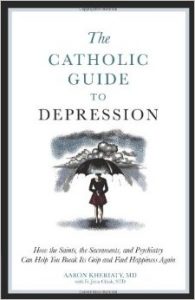The Catholic Guide to Depression: How the Saints, the Sacraments, and Psychiatry Can Help You Break Its Grip and Find Happiness Again
by Dr. Aaron Kheriaty
 The cover of The Catholic Guide to Depression depicts a woman standing in shadow, her face hidden by a large umbrella, with storm clouds looming over her and rain falling about her. Most of us have days when we feel like that. Some people live under oppressive clouds day after day after day.
The cover of The Catholic Guide to Depression depicts a woman standing in shadow, her face hidden by a large umbrella, with storm clouds looming over her and rain falling about her. Most of us have days when we feel like that. Some people live under oppressive clouds day after day after day.
Clinical depression, also termed a major depressive disorder, involves emotional and mental pain that can last a long time and tends to be recurrent. Its symptoms involve not only feelings of sadness, fear, or hopelessness, but also a host of cognitive and physical ill effects. Depression often manifests itself in difficulty with focus, changes in perception, sleep disruption, low energy, loss of appetite, psychomotor slowing or agitation, inappropriate feelings of guilt, inability to find joy in ordinarily pleasurable activities, frequent thoughts of death, and anxiety. The cover illustration hardly comes close to picturing the black pit of depression.
In this book Dr. Aaron Kheriaty, with the assistance of Msgr. John Cihak, blends science, theology, and philosophy into a wise and compassionate work on a difficult subject. Kheriaty is a psychiatrist who directs Residency Training and Medical Education for the Department of Psychiatry at the University of California, Irvine. Also UCI School of Medicine’s co-director of the Program in Medical Ethics, Kheriaty studied undergraduate philosophy at the University of Notre Dame and medicine at Georgetown University. Cihak is a priest of the Archdiocese of Portland (Oregon) who earned his licentiate and doctorate in theology at the Pontifical Gregorian University, where he now teaches.
Depression is a difficult subject both because it is complex and not well understood, and because it is a topic many people are unwilling to talk about above a whisper. Yet depression is among the more common medical illnesses. Most if not all of us know someone with depression and we may suffer from depression at some time during our own lifetime.
In the first third of this book, Kheriaty helps the reader grasp what depression is and is not. After describing the symptoms mentioned above, Kheriaty defines types of depression. He explains that while there is no easy answer to the question of what causes depression, possible contributing factors include genetics, brain chemistry abnormalities, and life circumstances.
This book provides an excellent explanation of the relationship between depression and the spiritual life. By delving into Christian beliefs about the fall and redemption, suffering, and God’s creative and transformative love, Kheriaty connects depression with the agony of the cross. Furthermore, he differentiates depression from acedia (sloth), the Dark Night of the Soul, and spiritual desolation, and discusses the interaction between depression and the spiritual and moral life.
Two more chapters round out the first part of the book: A short chapter describes the differences between depression and bipolar disorder, substance abuse, and anxiety disorders. A longer chapter is a very compassionate treatment of suicide, mustering evidence of how faith can be beneficial and pointing out the nuances and sensitivity of Catholic teaching on suicide.
Part Two of The Catholic Guide to Depression, the larger part of the book, focuses on overcoming depression. Kheriaty appraises both benefits and limitations of medication and other biological treatments, and of psychotherapy. He offers no “one size fits all” remedies or “quick fixes” but shows how various approaches can complement one another. Kheriaty believes that the effectiveness of psychotherapy depends upon the quality of the therapeutic relationship, i.e., the personal relationship between sufferer and healer. Here he defines the differences among types of therapists and describes the main psychotherapy methodologies.
Kheriaty maintains that treatment for depression should address not only physical and psychological issues but also spiritual concerns. The two final chapters go more deeply into spirituality, first by discussing how to cultivate virtues. Growth in virtue fosters what Kheriaty calls “unity of life, a healthy status; this does not mean that a virtuous person will never be depressed. Just as psychotherapy, medication, and other healing modalities entail a treatment plan, so too does spirituality benefit from planning. A concrete spiritual life plan should include prayer, spiritual reading, the Sacrament of Reconciliation, spiritual direction, and Mass, each of which receives thorough discussion. Lastly, the author talks about developing an ongoing awareness of God’s presence and he describes how “divine filiation” sustains hope. This chapter, like the rest of the book, is no bit of glib advice but deeply compassionate and wise counsel for those who know the anguish of depression.
Appendices list Internet and print resources plus prayers from the Psalms, saints, and Catholic tradition. Finally, there is a 2003 “Address of Pope John Paul II on the Theme of Depression” that, while addressed to therapeutic professionals, can give light to those who suffer from depression.
This intelligent and well-written book is a very fine resource for not only persons with depression but also those who love them and the pastors, parish ministers, and spiritual directors who serve them.
Reviewer information
Mary Ann Paulukonis was formerly a Registered nurse and Psychiatric Nursing instructor. Currently she assists Catholic parishes with leadership development and pastoral planning.
Disclaimer: Book reviews do not imply and are not to be used as official endorsement by the USCCB of the work or those associated with the work. Book reviews are solely intended as a resource regarding publications that might be of interest to For Your Marriage visitors.




